Hello, everyone! Today, I’ll be talking about one of my favorite clans in Cardfight Vanguard, which is the Zoo Clan, Great Nature!
The special theme of the clan is that the clan consists of genius animals with high IQs that focus mainly on learning. Through the seventy-fifth episode of the anime, I learned about the cute animals, which were played by the semi-antagonists of the season. The look and strength of the clan’s cards really appealed to me, especially when the team, S.I.T. Genius, beat the protagonist’s team. The focus of the clan was to give power to your units and draw more cards and in return, retire your rearguards at the end of your turn. There’s nothing more satisfying making your opponent suffer with the large hand you consistently have to defend and attack. The only downfall is that every draw you take is a step closer to decking out. Every clan has its own keyword, and for Great Nature, it’s Success. What success means is that whenever one of your rearguards reaches a certain amount of power, your units with the success ability become successful and activate another ability.
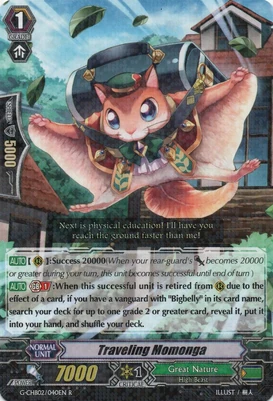
Here is an example of a Success card. As you can see, whenever a rearguard’s power becomes 20,000 or more, Traveling Momonga becomes successful. Momonga now gains another effect. If it is retired from an effect of a card and you have a card with Bigbelly in its name, you can add one grade 2 or greater to your hand.
Like most other clans, there are different ways to build a deck, but the more common ones I can think of are Bigbelly Success, Chatnoir and Tester Fox (Break Ride / Legion), Chatnoir and Guru Tiger (Break Ride and Legion), and Hammsuke for budget decks. I’ve wanted to also build a Chatnoir and Chatsauvage deck, but I’ve heard that the deck runs out of cards way too quickly. I’ll be going over the Bigbelly deck for today and may decide to add more decks in the future.
Grade 0:
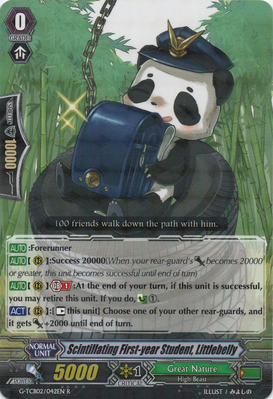
I’ll start with the Grade 0 starter, Scintillating First-year Student, Littlebelly. It is the only “Belly” and “Success” starter, so this is a standard choice. It’s successful effect is that when it becomes successful, you can retire it to counterflip (flip a card on your damage zone back up) once. I really like its other effect where you can rest the unit to give 2k to another unit.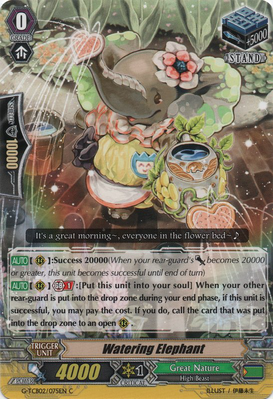
The triggers are pretty standard with 4x Heal Triggers, your own choice of Critical Triggers (at least 4 being Application Researcher, Ponbelly which is the Critical Trigger for Bigbelly), and and the rest of the triggers being Stand Triggers. Draw Triggers are absolutely unnecessary as it will only make you deck out quicker than you already do. I personally would run 6x Critical Triggers (4x Ponbelly and 2 Vanilla 5k Crit Triggers) and 6x Stand Triggers (3x Watering Elephant and 3x Chemical Skunk) for their effects. Other builds I’ve read run a 8x Crit, 4x Stand, and 4x Heal deck.
Grade 1: 
You will almost always run 4x of your Stride Fodder in every deck, which for Great Nature is Diligent Assistant, Minibelly.
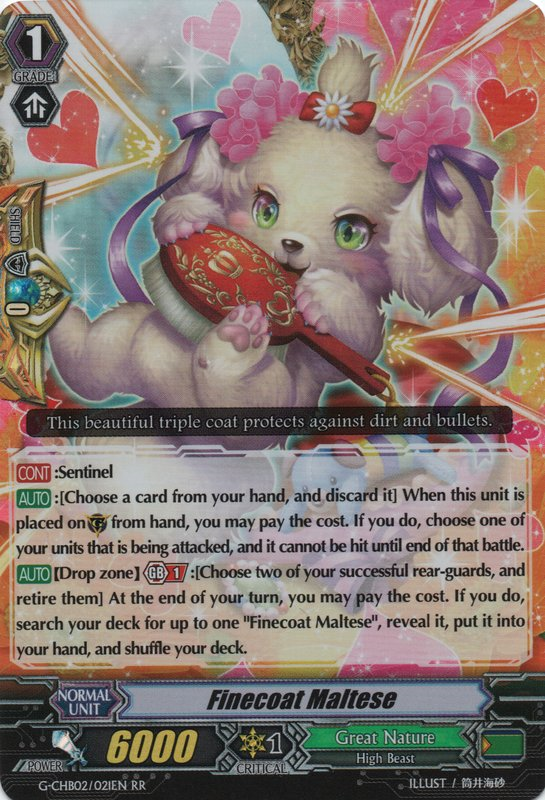 Then you would run 4x Perfect Guards, or Sentinels, which is either Finecoat Maltese or Contradictory Instructor, Shell Master. I would run Finecoat Maltese over Contradictory Instructor, Shell Master because Maltese can defend any of your units being attacked while Shell Master can only defend the Vanguard. Not only that, Shell Master’s effect is a Counterflip and Counterblasting for Great Nature does not occur that often. Maltese’s effect can be activated more often, which is at GB1, when the card is in the Drop Zone, you can retire two successful units and add a perfect guard into your hand. This really helps in scenarios where you don’t draw the PG you need and don’t want to waste your entire hand guarding your enemy’s attacks.
Then you would run 4x Perfect Guards, or Sentinels, which is either Finecoat Maltese or Contradictory Instructor, Shell Master. I would run Finecoat Maltese over Contradictory Instructor, Shell Master because Maltese can defend any of your units being attacked while Shell Master can only defend the Vanguard. Not only that, Shell Master’s effect is a Counterflip and Counterblasting for Great Nature does not occur that often. Maltese’s effect can be activated more often, which is at GB1, when the card is in the Drop Zone, you can retire two successful units and add a perfect guard into your hand. This really helps in scenarios where you don’t draw the PG you need and don’t want to waste your entire hand guarding your enemy’s attacks.
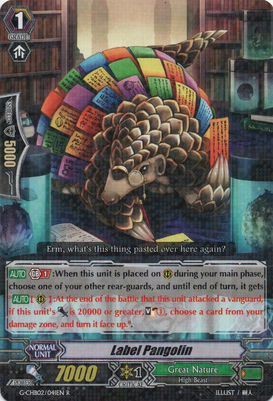 Other key cards you may want to run are Traveling Momonga, Label Pangolin, and Coiling Duckbill. I’ve talked about Momonga’s effect at the start of the post, which is when retired and successful, you would add a grade 2 or higher to your hand. This helps to get the Grade 3 you may need in your future turn to stride. Label Pangolin’s effect is to give another Rearguard an effect. The effect is at the end of the battle that the unit attacked, if the power was 20,000 or greater, SC (Soul Charge) 1 and turn a card from your damage zone face up. This card contributes to the counter flipping, which is why the PG Shell Master is unnecessary to add. The last G1 I mentioned was Coiling Duckbill. Its effect is to give another Rearguard to retire it at the end of turn and draw a card. This helps add more cards to your hand as you constantly retire with the deck. (Note: You can combo Coiling Duckbill with Stamp Sea Otter as the Otter’s effect is to not be retired if you have a Great Nature Vanguard.)
Other key cards you may want to run are Traveling Momonga, Label Pangolin, and Coiling Duckbill. I’ve talked about Momonga’s effect at the start of the post, which is when retired and successful, you would add a grade 2 or higher to your hand. This helps to get the Grade 3 you may need in your future turn to stride. Label Pangolin’s effect is to give another Rearguard an effect. The effect is at the end of the battle that the unit attacked, if the power was 20,000 or greater, SC (Soul Charge) 1 and turn a card from your damage zone face up. This card contributes to the counter flipping, which is why the PG Shell Master is unnecessary to add. The last G1 I mentioned was Coiling Duckbill. Its effect is to give another Rearguard to retire it at the end of turn and draw a card. This helps add more cards to your hand as you constantly retire with the deck. (Note: You can combo Coiling Duckbill with Stamp Sea Otter as the Otter’s effect is to not be retired if you have a Great Nature Vanguard.)
G2:
Key Grade 2 Units that are normally added are Problem Child Greybelly, Crayon Tiger, Lesser Writer, Full-sack Squirrel, and Geograph Giant.
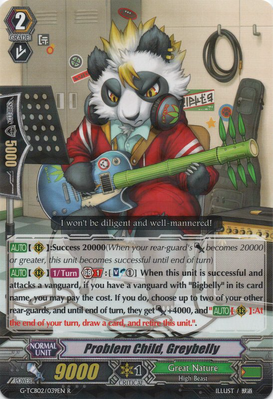 Problem Child, Greybelly seems pretty self-explanatory to add into the deck. His effect is when he is successful, attacks a vanguard, and has a vanguard with Big, you can SB (Soul Blast) 1 and give 2 other rearguards 4k power. The rearguards also get the effect of drawing a card and retiring them at the end of the turn. This card boosts your drawing potential and with the cost being a Soul Blast, you can easily achieve it with the Triggers that have effects to be placed into the soul.
Problem Child, Greybelly seems pretty self-explanatory to add into the deck. His effect is when he is successful, attacks a vanguard, and has a vanguard with Big, you can SB (Soul Blast) 1 and give 2 other rearguards 4k power. The rearguards also get the effect of drawing a card and retiring them at the end of the turn. This card boosts your drawing potential and with the cost being a Soul Blast, you can easily achieve it with the Triggers that have effects to be placed into the soul.
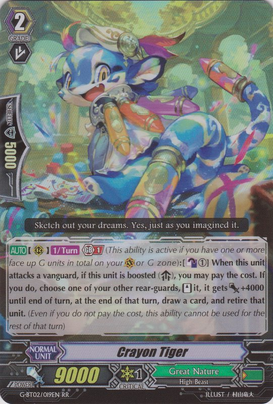
Crayon Tiger is always a staple to any Great Nature deck you plan on making. However, because its from an older set and a staple, its price is usually high with 1 of him being about $20. At the cost of GB1 and CB1, its effect is to stand another rearguard, give it 4k power, and the effect of retiring it at the end of your turn to draw a card. His effect is one of the only Counter Blasts you may use in an entire game.
The next card I’ll talk about is Lesser Writer. It also has a successful effect that if it is successful, all units with the success ability gains 2k and Resist. This success effect can easily be activated with its second effect. You can Soul Blast 1 card, make the unit successful, and have it retire at the end of your turn.
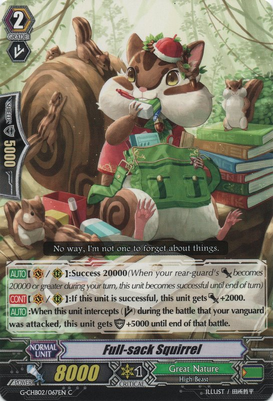 Full-sack Squirrel is a bit iffy for me to run because of its effect, but look at that chubby face of his.. IT’S SOO CUTE!! It gains 2k if it becomes successful and also a 5k shield if it intercepts. Because of its Success ability, it is a decent card to run.
Full-sack Squirrel is a bit iffy for me to run because of its effect, but look at that chubby face of his.. IT’S SOO CUTE!! It gains 2k if it becomes successful and also a 5k shield if it intercepts. Because of its Success ability, it is a decent card to run.
The last grade 2 I’ll mention is Geograph Giant. It is a standard 10k vanilla (no effect) card. It is run to stop rushing decks as it has a higher base power than most other cards in the game.
G3:
There are only 2 Grade 3’s that you would actually need to run for a Bigbelly deck. They are the old Famous Professor Bigbelly and the new Teacher’s Cane of Affection Bigbelly. They both have stride effects and most importantly have the Bigbelly name for other units in the deck.
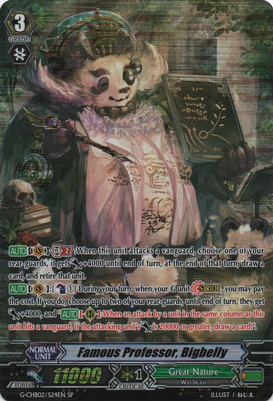
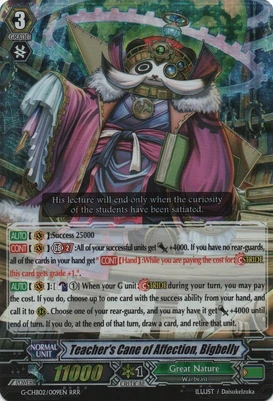
I prefer to Stride with Famous Professor, Bigbelly because it gives 4k power to two different rearguards and an effect that if the units in the same column that got the effect hit the vanguard, you get to draw a card (as long as the units have 20k+ power). However, Teacher’s Cane of Affection, Bigbelly is also a valid card to stride with. You can potentially have no Rearguards on your field, so you can’t use the older Bigbelly’s effect. The newer Bigbelly’s effect is to call a Rearguard with Success from your hand, give 1 rearguard 4k power, and at the end of the turn, retire it to draw a card. The newer Bigbelly is also more consistent in drawing more cards as you need to hit with the effects of the older Bigbelly.
This is it for now, and I hope you enjoy reading and coming back to this post as I may add more content and decks in the future!